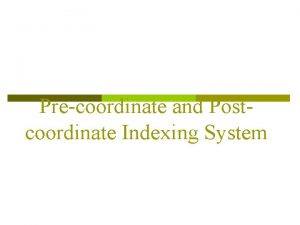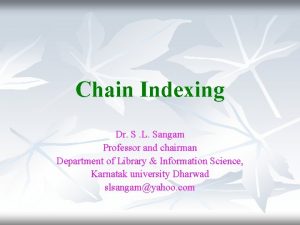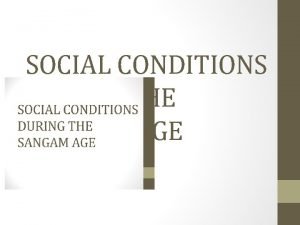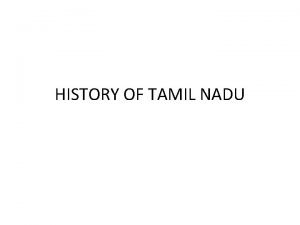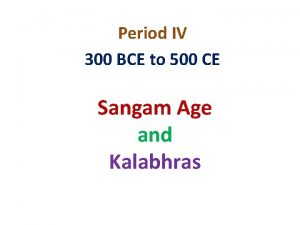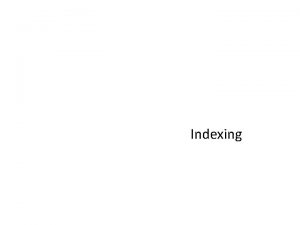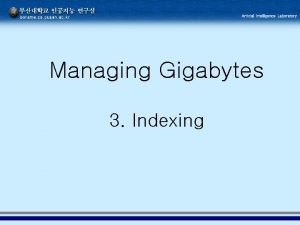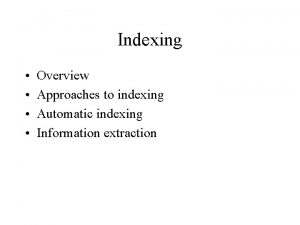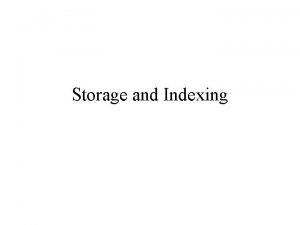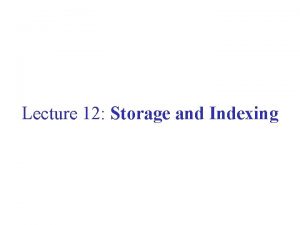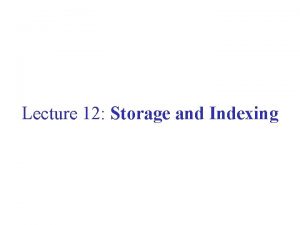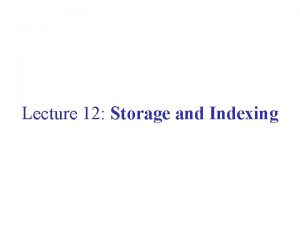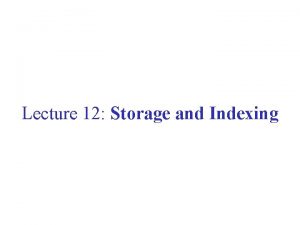Chain Indexing Dr S L Sangam Professor and















- Slides: 15

Chain Indexing Dr. S. L. Sangam Professor and chairman Department of Library & Information Science, Karnatak university Dharwad slsangam@yahoo. com

Introduction n Chain Indexing or chain procedure is a mechanical method to derive subject index entries or subject headings from the Class Number of the document. It was developed by Dr. S. R. Ranganathan. He first mentioned this in his book “Theory of Library Catalogue” in 1938. n In Chain Procedure the indexer or cataloguer is supposed to start from where the classifier has left. No duplication of work is to be done. He/she has to derive subject headings or class index entries from the digit by digit interpretation of the class number of the document in the reverse direction, to provide alphabetical approach to the subject of the document.

Cont n Ranganathan designed this new method of deriving verbal subject heading in 1934 to provide subject approach to documents through the alphabetical part of a classified catalogue. n This method was distinctly different from the enumerated subject heading systems like LCSH or SLSH. He discerned that classification and subject indexing were two sides of the same coin. n Classifying a document is the translation of its specific subject into an artificial language of ordinal numbers which results in the formation of a class number linking together all he isolate ideas in the form of a chain. n This chain of class numbers is retranslated into its verbal equivalent to formulate a subject heading that represents the subject contents of the document.

Cont n The class number itself is the result of subject analysis of a document into its facet ideas and linked together by a set of indicator digits, particularly when a classification system like colon Classification is used for the purpose. n As this chain is used for deriving subject entries on the basis of a set of rules and procedures, this new system was called ‘Chain Procedure’. This approach inspired in many other models of subject indexing developed afterwards, based upon classificatory principles and postulates. n Chain Indexing was originally intended for use with Colon Classification. However, it may be applied to any scheme of classification whose notation follows hierarchical pattern.

Step in Chain Indexing According to Bhattacharya, there are eleven steps involved in Chain Procedure: 1. Determination of the specific subject of the document. 2. Expressive name of the subject 3. Kernel terms 4. Analysed name of subject 5. Transformed name of subject 6. Standard terms 7. Determination of links and construction of chain. 8. Determination of different kinds of links 9. Derivation of subject headings 10. Preparation of cross reference entries 11. Arrangement.

Cont 1. Determination of specific subject of the document It is done with the help of the title of the document, its table of contents and by a careful perusal of the text. By analysing the subject contents of a document one arrives at its specific subject. 2. Expressive name of the subject Naming the specific subject of the document expressively in the natural language. 3. Kernel terms Representation of the name of the specific subject in Kernel terms (fundamental components). It is done by removing all the auxiliary words from the title. 4. Analyzed name of subject Determination of the category of each fundamental component according to a set of postulates and principles formulated for this purpose.

Cont 5. Transformed name of subject Transforming of the analysed name of subject by rearranging, if necessary, the fundamental components, according to a few additional postulates and principles formulated for the purpose of governing the syntax. 6. Standard terms Standardization of each term, in the transformed name of the subject, in accordance with the standard terms used in the preferred scheme of classification. 7. Determination of links and construction of chain Representation f class number in the form of a chain in which each link consists of two part-the class number and its translation in natural language. The class number and its translation is joined by “=” sign, and these signs are joined by downward arrows.

Cont 8. Determination of the different kinds of links Determination of different kinds of links such as Sought Link (SL), False Link (FL), Unsought Link (USL) and Missing Link (ML). FL : A link is a false link, if it ends with a connecting symbol or relation device, etc. USL: A link in which a user is not likely to approach a document. ML: A link in a chain-with-gap, corresponding to the missing isolate in the chain. SL: A link in which a user is likely to approach a document.

Cont 9. Derivation of subject heading Derivation of the subject heading from each of the sought links in the chain in a reverse rendering process. 10. Preparation of cross reference entries In this step subject reference entry is prepared for specific subject entries. 11. Arrangement In this last step all entries are merged and arranged in a single alphabetical sequence. Example: The document entitled ‘Macbeth’ by William Shakespeare, having class number O 111, 2 J 64, M will generate the following chain.

Cont O O 111, O 111, 2 J 64, M = Literature (SL) = Indo European literature (USL) = Teutonic literature (USL) = English literature (SL) = (FL) = English drama (SL) = Shakespeare (SL) = (FL) = Macbeth (SL)

Cont Corresponding to these five sought links, the following subject heading or class index entries will be generated by the above chain: DRAMA, ENGLISH O 11, 2 ENGLISH, LITERATURE O 111 LITERATURE O MACBETH, SHAKESPEARE (William) (1564) O 111, 2 J 64, M SHAKESPEARE (William) (1564)O 111, 2 J 64

Merits of Chain Indexing 1. This procedure, i. e. , chain indexing can be applied with ease to any classification scheme whose notational symbols indicate the subordination of each step of division e. g. CC, DDC, etc. 2. Chain indexing saves the time of the indexer, as he makes use of the class number provided by the classifier, thus, avoiding duplication of work, in analysing the document and the formulation of class number. 3. Chain indexing provides alternative approaches through reverse rendering to its classified file. 4. As chain procedure is based on the structure of the classification scheme and on the terminology found in the schedules, its operation is speedy and semi-mechanical. 5. Chain procedure is economical, as it drops each term after it has been indexed, thus, avoiding the permutation of component terms.

Cont 6. In case of chain indexing, only one index heading with complete subject formulation is prepared for a specific document. Other entries are prepared by successive dropping of terms serve successfully larger number of specific subjects. This provides the facility for generic as well as specific searches. 7. Chain procedure is amenable to computerization. Programmes are being successfully written to generate subject headings both from class numbers and feature headings following the reverse rendering method. 8. Chain procedure may be used to derive indexes to classification schemes and books. Similarly, it may be used in formulating headings necessary for guide cards on catalogue, stock room guides, shelf guides, etc. , in a systematic way.

Demerits of Chain Indexing 1. It is totally dependent on a scheme of classification, as a result it tends t suffer demerits related to the scheme of classification automatically. 2. The entries prepared through chain indexing has only one specific entry, others are all broad entries. 3. In chain indexing, sometimes a step of division may go un-represented, by a further digit of the class number. This creates the problem of missing chain. 4. Reverse rendering of terms, while preparing the entries is confusing to the user.

Conclusion Chain indexing was first used by the Madras University Library in 1936. It has been widely accepted and used by BNB from 1950 -1970, LISA is based on Chain Indexing, INB has been practicing chain indexing since 1958. DRTC has lately found that chain procedure is fuly amenable to computerization. Programmes are being written to generate subject heading from class numbers following reverse rendering method.
 Pre coordinate indexing
Pre coordinate indexing Contoh pengindeksan manual
Contoh pengindeksan manual Promotion from assistant to associate professor
Promotion from assistant to associate professor Food chain sequence
Food chain sequence Chain procedure in library science
Chain procedure in library science Chain indexing system
Chain indexing system Social life of sangam age
Social life of sangam age Sangam mulmi
Sangam mulmi The word sangam means
The word sangam means During lecture
During lecture Sri lanka and tamil nadu map
Sri lanka and tamil nadu map Metadata meaning in tamil
Metadata meaning in tamil Amar seva sangam ayikudi contact number
Amar seva sangam ayikudi contact number Value chain and supply chain difference
Value chain and supply chain difference Open kinetic chain
Open kinetic chain Simple indexing
Simple indexing
